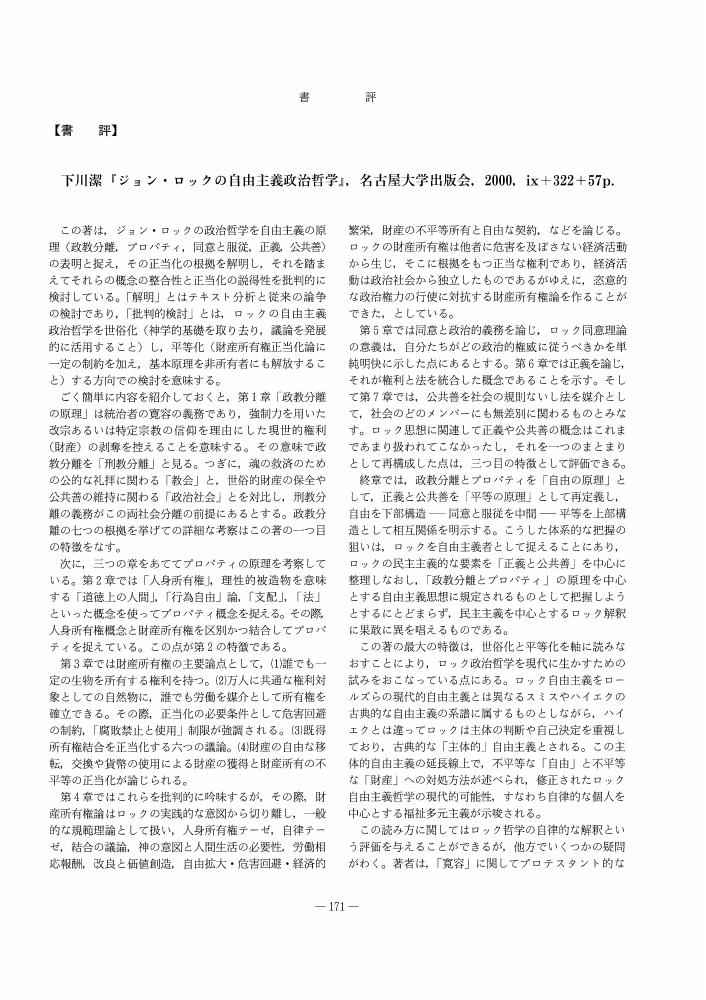7 0 0 0 OA <論説>R. フィルマーの政治思想
- 著者
- 岡村 東洋光
- 出版者
- 九州産業大学
- 雑誌
- エコノミクス : ekonomikusu (ISSN:13424572)
- 巻号頁・発行日
- vol.1, no.3, pp.1-37, 1997-03-31
3 0 0 0 OA 『クエーカー企業家 ジョーゼフ・ラウントリーの生涯1836-1925』(上)
- 著者
- ヴァーノン アン 岡村 東洋光 佐伯 岩夫
- 出版者
- 九州産業大学
- 雑誌
- エコノミクス : ekonomikusu (ISSN:13424572)
- 巻号頁・発行日
- vol.10, no.2, pp.65-126, 2006-03-30
- 著者
- 岡村 東洋光
- 出版者
- 経済学史学会
- 雑誌
- 経済学史研究 (ISSN:18803164)
- 巻号頁・発行日
- vol.48, no.1, pp.155-156, 2006-06-30 (Released:2010-08-05)
1 0 0 0 OA ジョーゼフ・ラウントリーのガーデン・ビレッジ構想
- 著者
- 岡村 東洋光
- 出版者
- The Japanese Society for the History of Economic Thought
- 雑誌
- 経済学史学会年報 (ISSN:04534786)
- 巻号頁・発行日
- vol.46, no.46, pp.31-47, 2004 (Released:2010-08-05)
- 参考文献数
- 63
The purpose of this paper is to investigate Joseph Rowntree's philanthropy, and in particular, the Garden Village he founded, and then to clarify the importance of it as the model of a community that was like a neighbourhood unit, and as the inspiration behind the creation of the Welfare State in Britain.In the late 19th century, two successful entrepreneurs, T. Salt and E. Akroyd, had founded the villages of Saltaire and Akroydon, respectively. They were located very close to the big mills that employed their workers. These villages somewhat improved the living conditions of their employees. In London, some funding was invested in improving housing conditions and received a 5per cent commercial return. Subsequently, the setting up of the Peabody Trust in 1862 led the way for others to follow, and the endowment of trusts by philanthropic individuals developed through the Guinness Trust which was started in 1889, the Sutton Housing Trust, founded in 1900, and the Samuel Lewis Trust, foundes in 1906.But the great estate William Sutton left gave rise to fundamental social and political issues, in particular the role of charity in the provision of housing and relief of poverty. The size of his bequest raised fears that the trust could monopolise housing for the poor, disrupting local housing markets and undermining the rateable base of local authority income. Finally, the High Court of Chancery retained the direction of the Sutton Trust's affairs, exercising control over the initial funds and all surpluses generated.Around the same time, in Birmingham, the Cadbury family moved their factory from the city centre to the countryside, to a site later renamed Bournville. While the factory was under construction, some attractive cottages were erected nearby. An experimental housing estate followed a few years later, which in 1900 became the Bournville Village Trust, a product of the age that created the Garden Cities' movement. In a sense, it was the philanthropic ideal that created this community.In 1904, Joseph Rowntree, using approximately half his fortune, set up three separate Trusts. One of those was the JR Village Trust, which was concerned with living conditions and in particular with the houses at New Earswick, known as Garden Village. Through this Trust, an effort was made to provide houses that were artistic in appearance, sanitary, and thoroughly well-built yet within the means of working men earning about 25s. a week (i. e., the lowest incomegroup). In short, this project aimed to improve the housing of Rowntree's workers. Rowntree simultaneously intended to create a community that functioned like a neighbourhood unit. And so, for the inhabitants, the new village would mean something more than bricks and mortar.Through the founding Garden Village and the providing of houses for his workers, the middle-class Rowntree philanthropically pursued social reform for the public good as he saw it. We can say that the Garden Village still lives on, and continues to play the role for which Rowntree intended it, of providing welfare for the poor.
- 著者
- 岡村 東洋光 下川 潔
- 出版者
- 経済学史学会
- 雑誌
- 経済学史学会年報 (ISSN:04534786)
- 巻号頁・発行日
- vol.39, no.39, pp.171-173, 2001 (Released:2010-08-05)
- 著者
- 岡村 東洋光
- 出版者
- 東京大学経済学会
- 雑誌
- 経済学論集 (ISSN:00229768)
- 巻号頁・発行日
- vol.78, no.1, pp.2-15, 2012-04
特集 : フィランスロピーの国際比較 : 公と私の間でSpecial Issue : An International Comparison Study on Philanthropy : Between Public and Private Spheres
1 0 0 0 OA ジョーゼフ・ラウントリーの「公益」思想 : 三トラストの活動を中心に
- 著者
- 岡村 東洋光
- 出版者
- 東京大学経済学会
- 雑誌
- 經濟學論集 (ISSN:00229768)
- 巻号頁・発行日
- vol.78, no.1, pp.2-15, 2012-04
特集 : フィランスロピーの国際比較 : 公と私の間で
1 0 0 0 OA 経済学部学生の日本語力に関する調査報告
- 著者
- 岡村 東洋光
- 出版者
- 九州産業大学
- 雑誌
- エコノミクス : ekonomikusu (ISSN:13424572)
- 巻号頁・発行日
- vol.12, no.1, pp.77-92, 2007-10



